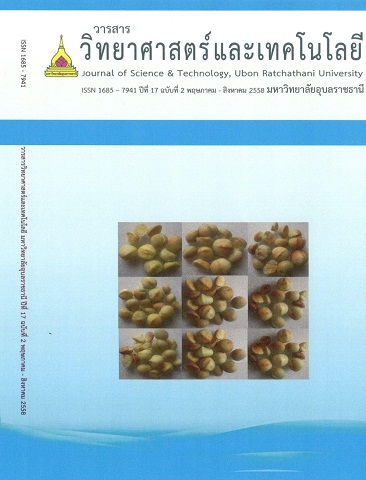Nutrients and Phenolic Acids in Krung Ba Dan (Cyclea barbata Miers) Leaves and Aqueous Extract from Ubon Ratchathani Province
Main Article Content
บทคัดย่อ
Krung ba dan is a slender, deciduous climber widespread in tropical regions, including Thailand The aqueous extract from the leaves has a unique characteristic in that gel forms by itself at room temperature. The extract is widely used in a traditional dish called Pon-ma-noi, commonly consumed in North-Eastern Thailand, including Ubon Ratchathani province. This study aimed to determine the nutritional composition and phenolic acids in Krung ba dan (Cyclea barbata Miers) leaves and the aqueous extract. The nutritional composition was analysed according to the AOAC official methods. Krung ba dan leaves (77% moisture content) were composed of 16.7 g carbohydrate, 4.2 g protein, 0.4 g fat, 1.7 g ash, 8.6 g soluble dietary fiber, 1.2 g insoluble dietary fiber, and 237.2 mg calcium per 100 g of sample. The aqueous leaf extract (97.7% moisture content) consisted of 1.7 g carbohydrate, 0.4 g protein, 0.2 g ash, 1.5 g soluble dietary fiber, and 15.2 mg calcium per 100 g of sample. Phenolic acids were identified in freeze-dried leaves and gel extract, and these were chlorogenic acid (15.5, 11.1 mg/100 g), ferulic acid (9.8, 8.3 mg/100 g), and p-coumaric acid (6.3, 3.6 mg/100 g). In summary Krung ba dan leaves and the aqueous extract containing high soluble fiber content and phenolic compounds may have potential health benefits, and on-going studies based on the gel characteristics, other bioactive compounds, and antioxidant activities should help confirm them.
กรุงบาดาลเป็นสมุนไพรไม้เลื้อยที่พบได้ในประเทศเขตอบอุ่น รวมถึงประเทศไทย ใบมีลักษณะพิเศษ เมื่อนำมาสกัดด้วยน้ำในแบบครัวเรือนสามารถเกิดเป็นเจลได้เองที่อุณภูมิห้องโดยไม่ต้องเติมองค์ประกอบอื่นเพิ่มเติม คนท้องถิ่นในภาคตะวันออกเฉียงเหนือมักนำใบมาขยี้กับน้าเกิดเป็นเจลสสมกับป่นปลาและบริโภคเป็นอาหาร เนื่องด้วยสมบัติการเกิดเจลที่น่าสนใจและการบริโภคที่พบในวงจำกัด งานวิจัยชิ้นนี้จึงมีวัตถุประสงค์เพื่อศึกษาคุณค่าทางโภชนาการและปริมาณกรดฟีนอลิกของเจลและใบกรุงบาดาล การศึกษาคุณค่าทางโภชนาการในใบสดและเจลสดตามวิธีมาตรฐานสากล AOAC พบว่า ใบสด 100 กรัม มีความชื้น 77% มีองค์ประกอบเป็นคาร์โบไฮเดรต 16.7 กรัม โปรตีน 4.2 กรัม ไขมัน 0.4 กรัม เถ้า 1.7 กรัม ใยอาหารชนิดที่ละลายน้ำ 8.6 กรัม ใยอาหารชนิดไม่ละลายน้ำ 1.2 กรัม และแคลเซียม 237.2 มิลลิกรัม เจลสด 100 กรัม มีความชื้น 97.7% ประกอบด้วยคาร์โบไฮเดรต 1.7 กรัม โปรตีน 0.4 กรัม เถ้า 0.2 กรัม ใยอาหารชนิดที่ละลายน้ำ 1.5 กรัม และแคลเซียม 15.2 มิลลิกรัม การวิเคราะห์ปริมาณกรดฟีนอลิกในใบและเจลที่ส่านการทำแห้งแบบแช่เยือกแข็ง พบกรดคลอโรเจนิก (15.5 มิลลิกรัม และ 11.1 มิลลิกรัม ต่อ 100 กรัม ตัวอย่างใบและเจล ตามลำดับ) กรดเฟอริวลิก (9.8 มิลลิกรัม และ 8.3 มิลลิกรัม ต่อ 100 กรัม) และกรดพีคูมาริก (6.3 มิลลิกรัม และ 3.6 มิลลิกรัม ต่อ 100 กรัม) โดยสรุป ใบและเจลจากใบกรุงบาดาลมีปริมาณใยอาหารชนิดละลายน้ำอยู่สูงและมีกรดฟีนอลิกเป็นองค์ประกอบจึงมีแนวโน้มใช้เป็นสมุนไพรและอาหารพื้นบ้านที่มีประโยชน์ นอกจากนี้ การศึกษาเพิ่มเติมเกี่ยวกับคุณลักษณะของเจล สารออกฤทธิ์ทางชีวภาพ การทดสอบฤทธิ์การต้านอนุมูลอิสระ เพื่อผลเชิงประจักษ์เกี่ยวกับประโยชน์ต่อสุขภาพ จะสามารถส่งเสริมการบริโภคให้แพร่หลายมากขึ้นได้
Article Details
บทความที่ได้รับการตีพิมพ์เป็นลิขสิทธิ์ของ วารสารวิทยาศาสตร์และเทคโนโลยี มหาวิทยาลัยอุบลราชธานี
ข้อความที่ปรากฏในบทความแต่ละเรื่องในวารสารวิชาการเล่มนี้เป็นความคิดเห็นส่วนตัวของผู้เขียนแต่ละท่านไม่เกี่ยวข้องกับมหาวิทยาลัยอุบลราชธานี และคณาจารย์ท่านอื่นๆในมหาวิทยาลัยฯ แต่อย่างใด ความรับผิดชอบองค์ประกอบทั้งหมดของบทความแต่ละเรื่องเป็นของผู้เขียนแต่ละท่าน หากมีความผิดพลาดใดๆ ผู้เขียนแต่ละท่านจะรับผิดชอบบทความของตนเองแต่ผู้เดียว


